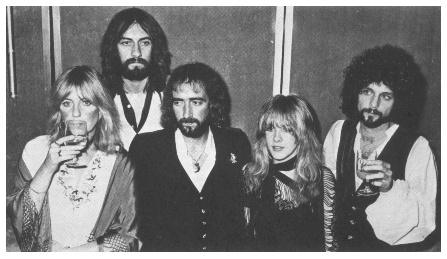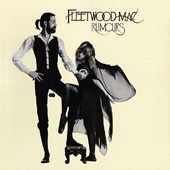|
Fleetwood Mac Warner Brothers 8371 June 1977 Billboard: #1
Having survived more personnel changes than Macy's, the 1977 members of Fleetwood Mac were experiencing emotional upheavals while recording Rumours, the album that had a 31-week run at number one and produced the band's only chart-topping single, "Dreams."
Only Mick and John, who had both played in John Mayall's Bluesbreakers, were part of the original Fleetwood Mac, formed in 1967. It was in April of that year that Aynsley Dunbar left the Bluesbreakers to join Rod Stewart in Jeff Beck's band. Replacing Dunbar was Mick Fleetwood, who joined Peter Green and John McVie. Fleetwood was fired from the group and Green quit shortly after. With lead guitarist Jeremy Spencer, they formed the first incarnation of Fleetwood Mac. McVie joined a month later. Just after their second album was released, Green suggested adding Danny Kirwan, giving the group three lead guitarists. In January, 1969, this line-up of Fleetwood Mac scored the group's only British number one single, the instrumental "Albatross." Green departed in May, 1970, and later in the year, just before an American tour, John McVie's wife, pianist/vocalist Christine Perfect, gave up being a housewife to become part of Fleetwood Mac. Before her voluntary "retirement," she had been named Melody Maker's top female vocalist of 1969. During the American tour, Spencer went missing for five days. By the time the band discovered his whereabouts, he had joined a California sect called the Children of God. Green filled in for him until a permanent replacement was found -- the group's first American citizen, Bob Welch. As the group took on more of a West Coast sound, there were still personnel changes to come. Kirwan was fired and Welch left. Bob Weston and Dave Walker had short tenures with the band, and in November, 1974, Fleetwood was in a Los Angeles supermarket when someone suggested he check out he Sound City studios in Van Nuys. There, engineer Keith Olsen demonstrated the studio's capabilities by playing a tape of an album called Buckingham Nicks. Lindsey Buckingham and Stevie Nicks happened to be in an adjoining studio and came over to find out who was listening to their music. A few weeks later, Mick asked the two Americans to join the band. It was this Anglo-American line-up that spend 10 days recording an album at Sound City. Titled simply Fleetwood Mac, it yielded three top 20 hits: "Over My Head," "Rhiannon (Will You Ever Win)" and "Say You Love Me." Their next LP, Rumours, did even better. It was the first album by a group to produce four top 10 singles: "Go Your Own Way," "Dreams," "Don't Stop" and "You Make Loving Fun." One of several statements from Rumours' internal conversations about their romantic trials, "Dreams" can be viewed as Stevie Nicks' reply to Lindsey Buckingham's "Go Your Own Way." Whereas Buckingham sounded downright volatile, Nicks adapts a more stealthy tack -- an "I can't live with you/can't live without you" approach. Though "Dreams" clocks in at over four minutes, it's a measure of Nicks' artistic development that the long-drawn-out melody line (only punctuated by the chorus) doesn't become tedious, and the sheer subtlety of the arrangement allows the song to grow at its own pace. - Fred Bronson, The Billboard Book of Number One Hits, Billboard, 1988.
No comments so far, be the first to comment. |


